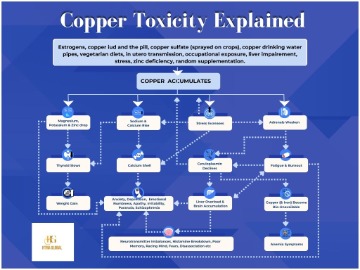
Introduction
Copper is one of the most commonly-encountered imbalances that we find on tissue mineral analysis tests. Many of the most prevalent metabolic dysfunctions of our time are related in some way to a copper imbalance. Copper directly or indirectly affects virtually every body system. Many symptoms associated with copper toxicity are due to a copper-induced deficiency, or deficiency of vitamin C, folic acid, or other nutrients induced by copper toxicity. Copper also interferes with adrenal and thyroid gland activity, creating another set of symptoms relating to hypothyroidism and adrenal insufficiency.
Sources Of Copper Imbalance
Copper imbalance can result from:
- environmental copper exposure.
- adrenal gland insufficiency or exhaustion.
- zinc deficiency.
- congenital copper toxicity.
- the ‘copper personality’.
Environmental Copper
Copper Water Pipes
Copper plumbing was hailed as a great advance in the 1940’s, and today the majority of homes in the United States have copper plumbing. Especially in areas with acidic water, copper can be leached from pipes, leaving in severe cases, a greenish ring on bathroom fixtures. Water coolers and ice-makers in refrigerators also use copper tubing. Water that sits in these units can contain dangerously high levels of copper.
Copper Cookware
Copper tea kettles and other copper cookware can be a source of copper toxicity if used frequently over a period of time. Acidic type foods, such as tomatoes and okra add considerably to the problem.
Drinking Water Contaminated With Copper
Some areas of the United States have high amounts of naturally-occurring copper in their water supply. Also, copper sulfate is added to some municipal drinking water supplies to kill yeast and fungi.
Birth Control Pills and Copper Intra-Uterine Devices
One of the side effects of the pill is that it tends to raise copper levels in the body. This is due to the close association between the hormone estrogen and copper levels.
Several hundred milligrams of copper a year can easily be absorbed from a copper IUD. ParaGard is the only copper IUD available in the United States today. It can prevent pregnancy for up to 10 years after insertion; however, these devices can be very harmful for women prone to high copper levels.
Vitamin and Mineral Supplements
Copper is frequently added to vitamin supplements, particularly prenatal vitamins. Although this is a benefit for some people, it can be harmful for many other women.
Fungicides for Swimming Pools and Foods
Copper sulfate is added to swimming pools and may be sprayed on fruits and vegetables to retard growth of algae and fungus.
Vegetarianism and Other High-Copper Diets
Many diets today are high in copper. In particular, vegetarian proteins such as soybean, nuts, seeds, tofu, avocado and grains are high in copper content. Fast food hamburgers and other popular foods are soy-based. Soybean protein is coming into wider usage, due to its low cholesterol level and lower cost.
Other high-copper foods are organ meats, shellfish, wheat germ and bran, yeast, corn oil, margarine, and mushrooms.
Although nuts are a very healthful food, some nuts are particularly high in copper content. These include Brazil nuts, almonds, hazelnuts, walnuts and pecans, all of which contain more copper than beef liver.
Black pepper, thyme, paprika, bay leaves, and active dry yeast are also high in copper.
Occupational Exposure
Plumbers, welders, machinists, electricians and others who work with copper are at risk for copper toxicity.
Dental Appliances
Copper is used in dental alloys in fillings, crowns and other appliances.
Adrenal Gland Exhaustion And Copper Toxicity
Diminished adrenal activity is perhaps the single most important physiological reason for copper problems today. The reason is that adrenal activity is required to stimulate production of ceruloplasmin, the primary copper-binding protein.
When adrenal activity is insufficient, ceruloplasmin synthesis in the liver declines. Copper that is not bound cannot be utilized, and unbound copper begins to accumulate in various tissues and organs.
According to hair analysis research, 70-80% of people tested show weak adrenal glands!
Zinc deficiency and copper Toxicity
A widespread zinc deficiency in our population is another critical cause of copper imbalance. Zinc and copper normally exist in a delicate balance. Zinc is a primary copper antagonist. When zinc is deficient, copper tends to accumulate in various storage organs.
Zinc deficiency is extremely common today. Dr. Carl Pfeiffer has stated that the entire American population is borderline deficient in zinc. A zinc deficiency is due to:
- acute stress of any kind causes increased excretion of zinc.
- a high sugar and carbohydrate diet lowers tissue zinc levels.
- vegetarian diets are lower in zinc, since a main source of zinc in the diet is derived from meat protein, particularly red meat.
- low levels of zinc in the soil resulting in lowered zinc levels in foods.
- refining of food removes zinc.
- many children today are born deficient in zinc because their mothers are deficient.
Congenital Copper Imbalance
Mothers deficient in zinc, or high in copper, transmit these imbalances to their children through the placenta.
Untold numbers of children today are born with a copper imbalance. Often they suffer from learning problems, developmental disability, chronic infections and other problems.
Mothers also pass on to their offspring other nutrient deficiencies and toxic metals, which impairs the child’s adrenal glands. Weak adrenal glands, in turn, results in a worsening of the copper imbalance in the child by the mechanism explained above.